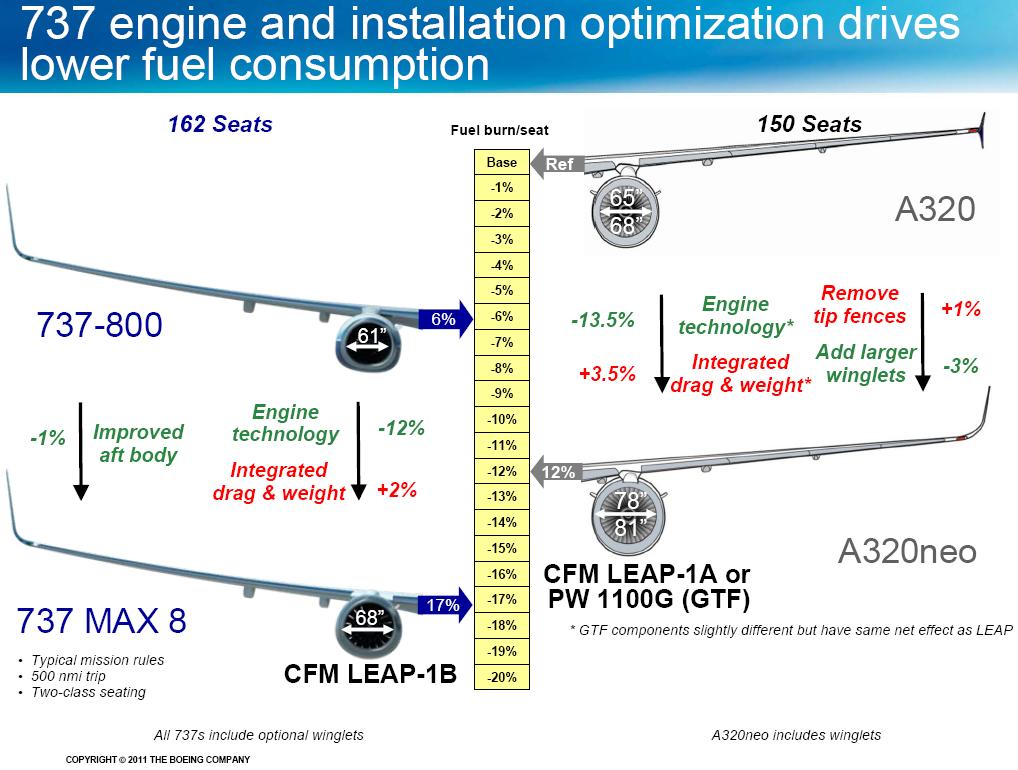The war of words between Airbus and Boeing continued unabated at the Pacific Northwest Aerospace Alliance 11th Annual Conference this week in suburban Seattle.
As fully expected, Airbus said its planes are better than Boeing and Boeing said its planes are better than Airbus. No news there.
But Boeing revealed a little bit more detail on the 737 MAX vs the A320 neo that suggests their analysis gives another percentage point advantage than was originally announced last August.
When MAX was announced, Boeing claimed, “The airplane’s fuel burn is expected to be 16 percent lower than our competitor’s current offering and 4 percent lower than their future offering” and “It will have the lowest operating costs in the single-aisle segment with a 7 percent advantage over the competition.” The slide shows an additional 1% advantage for fuel burn over neo and 17% over A320CEO (Current Engine Option, as Airbus now calls it), of +5 (VS 4) and +17 (vs 16). We asked Boeing about this, and we’re told the slide reflects rounding up the numbers and not an actual increase in the previously announced economic claims.
 Randy Tinseth, VP Market, showed this slide (click on the slide to enlarge), the first time we’ve seen one like it. The slide shows the improved fuel burn minus the negative impact of additional weight and drag to come up with net figures.
Randy Tinseth, VP Market, showed this slide (click on the slide to enlarge), the first time we’ve seen one like it. The slide shows the improved fuel burn minus the negative impact of additional weight and drag to come up with net figures.
What is also useful is that Boeing includes in the illustration the existing and planned fan diameters for the 737-800, the A320 and their successor airplanes. The assumptions used in the analysis are also listed on the slide.
Airbus disputes the underlying Boeing analysis as well as claiming the assumptions used favor Boeing instead of real-world operating conditions. We covered the Airbus detail following ISTAT’s European Conference in Barcelona. We sought out Boeing at that time in order to include their detail in that posting; Boeing declined. Boeing held a tele-conference November 4, but it could only be characterized as a high-level look at the program. We’ve been trying for months (since last June, in fact) to follow up their briefing in advance of the Paris Air Show and Boeing has been declining all interview requests on MAX.
CFM has likewise declined interview requests (three since August, when MAX was launched). Both companies have left the marketplace in a fog. But information obtained from customers, from Boeing and from within CFM has now painted a reasonable picture of how Boeing and CFM support their claims that the 737 MAX will be more economical than neo and how the LEAP is being optimized for MAX. In addition to the Airbus position, it should also be noted that at least one airline analysis of the MAX vs neo concludes that MAX will only be around 2% better than neo, not the 7%-8% lower operating costs claimed by Boeing.
The purpose of this post is not to attempt an independent analysis, but rather to explain why Boeing and CFM make the claims they do. This report is the result of months of talking with customers and sources within Boeing and CFM; and from public appearances by Boeing and CFM.
Read more


